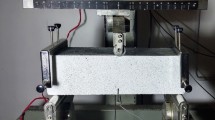Abstract.
In this paper, a unit cell based approach is followed, where a unit cell consisting of one aggregate surrounded by mortar matrix is used for numerical simulation of mechanical response of cement concrete. Unit cell approach is a simple mathematical approximation that helps us to simplify the simulation of mechanical response of multi-phase composites. To model the failure of matrix, brittle cracking model is used, where the entire fracture zone is represented by a band of micro cracked material. Current study involves; (a) failure analysis of the concrete unit cell when it is subjected to tensile loads, and (b) parametric study of variation of peak strength with shape and volume fraction of aggregate. In this study, circular and square aggregates at various orientations are modelled. The simulation results predict that the peak tensile stresses are not very sensitive to the volume fraction of aggregates, when the unit cell is subjected to tensile loads. This paper effectively demonstrates the power of unit cell model in simulating the nonlinear mechanical response of cement concrete when it is subjected to tensile loading.
Similar content being viewed by others
References
ABAQUS 6.7ef 2007 Documentation, Dassault Systèmes December 12
Gitman I M, Askes H, Sluys L J 2008 Coupled-volume multi-scale modelling of quasi-brittle material. Eur. J. Mech. A/Solids, 27: 302–327
Guo L-P, Carpinteri A, Roncella R, Spagnoli A, Sun W, Vantadori S 2009 Fatigue damage of high performance concrete through a 2D mesoscopic lattice model. Comput. Mater. Sci. 44(4): 1098–1106
Hafner S, Eckardt S, Luther T, Konke C 2006 Mesoscale modeling of concrete: Geometry and numerics. Comput. Struct. 84: 450–461
Hillerborg A, Modeer M, Petersson P E 1976 Analysis of crack formation and crack growth in concrete by means of fracture mechanics and finite elements. Cement and Concrete Res. 6: 773–782
Kouznetsova V, Brekelmans W A M, Baaijen F P T 2001 An approach to micro-macro modeling of heterogeneous materials. Computational. Mech. 27: 37–48
Kwan A K H, Wang Z M, Chan H C 1999 Mesoscopic study of concrete II: nonlinear finite element analysis. Comput. Struct. 70: 545–556
Leite J P B, Slowik V, Mihashi H 2004 Computer simulation of fracture processes of concrete using mesolevel models of lattice structures. Cement and Concrete Res. 34: 1025–1033
Lemaitre J 1987 Continuum damage mechanics theory and applications. Wien-New York Springer.
Mehta P K, Monteiro P J M 1993 Concrete: Microstructure, properties and materials. Indian Concrete Institute
Sadouki H, Wittmann F H 1988 On the analysis of the failure process in composite materials by numerical simulation. Mater. Sci. Eng. A104: 9–20
Schlangen E, Van Mier J G M 1992 Experimental and numerical analysis of micro-mechanisms of fracture of cement-based composites. Cement and Concrete Composites 14: 105–118
Schorn H, Rhode U 1991 Numerical simulation of crack propagation from microcracking to Fracture. Cement and Concrete Composites 13: 87–94
Shioya S 1967 On a semi-infinite thin plate with a circular inclusion under uniform tension. JSME 42: 623–636
Spagnoli A 2009 A micromechanical lattice model to describe the fracture behaviour of engineered cementitious composites. Comput. Mater. Sci. 46(1): 7–14
Van der Sluis O, Schreurs P J G, Brekelmans W A M, Meijer H E H 2000 Overall behaviour of heterogeneous elastoviscoplastic materials: Effect of microstructural modelling. Mechanics of Materials 32: 449–462
Van Mier J G M 1996 Fracture processes of concrete-assessment of material properties for fracture models. CRC Press
Vonk R A 1992 Softening of concrete loaded in compression. PhD thesis, Eindhoven University of Technology, The Netherlands
Wang Z M, Kwan A K H, Chan H C 1999 Mesoscopic study of concrete: generation of random aggregate structure and finite element mesh. Comput. Struct. Pergamon Press Ltd., 70: 533–544
Wriggers P and Moftah S O 2006 Mesoscale models for concrete: Homogenisation and damage behaviour. Finite elements in analysis and design 42: 623–636
Author information
Authors and Affiliations
Corresponding author
Rights and permissions
About this article
Cite this article
GHOUSE, M., RAO, C.L. & RAO, B. Numerical modelling of failure of cement concrete using a unit cell approach. Sadhana 36, 35–51 (2011). https://doi.org/10.1007/s12046-011-0008-6
Received:
Revised:
Accepted:
Published:
Issue Date:
DOI: https://doi.org/10.1007/s12046-011-0008-6




